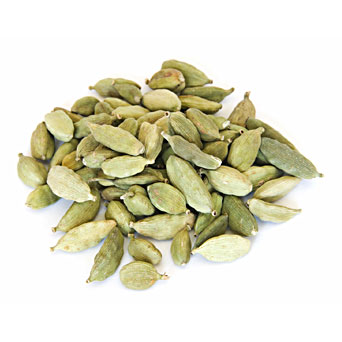Samarth RM, Samarth M, Matsumoto Y Future Science OA, 2017 ABSTRACT: Aromatic plants are often used as natural medicines because of their remedial and inherent pharmacological properties. Looking into natural resources, particularly products of plant origin, has become an exciting area of research in drug discovery and development. Aromatic plants are mainly exploited for essential oil extraction… Read more »

- Botanical Name: Elettaria cardamomum
- Alternative Names: Cardomon, Heel Khurd, Queen of Spices
- Botanical Family: Zingiberaceae
- Primary Constituent: Terpinyl acetate
- Other Main Constituents: 1,8-cineole, Linalyl acetate
- Distillation Method: Steam Distillation
- Plant Part: Seed
Anti-oxidant activity and major chemical component analyses of twenty-six commercially available essential oils
Wang HF, Yih KH, Yang CH, Huang KF Journal of Food and Drug Analysis, 2017 ABSTRACT: This study analyzed 26 commercially available essential oils and their major chemical components to determine their antioxidant activity levels by measuring their total phenolic content (TPC), reducing power (RP), β-carotene bleaching (BCB) activity, trolox equivalent antioxidant capacity (TEAC), and 1,1-diphenyl-2-picrylhydrazyl free… Read more »
Evaluating the antimicrobial potential of green cardamom essential oil focusing on quorum sensing inhibition of Chromobacterium violaceum
Abdullah, Asghar A, Butt MS, Shahid M, Huang Q Journal of Food Science and Technology, 2017 ABSTRACT: Spices are well known for their taste and flavor imparting properties. Green cardamom (Elletaria cardamomum), a herb spice belongs to family Zingiberaceae. In current study, GC-MS analysis of green cardamom essential oil (CEO) resulted in identification of twenty-six compounds with α-terpinyl acetate (38.4%), 1,8-cineole (28.71%), linalool… Read more »
Eucalyptol, sabinene and cinnamaldehyde: potent inhibitors of salmonella target protein L-asparaginase
Vimal A, Pal D, Tripathi T, Kumar A 3 Biotech, 2017 ABSTRACT: Salmonella typhimurium is a severe threat to human life. The treatment became more difficult with the emergence of multidrug resistance. In the present in silico study, a novel drug target L-asparaginase was tested against three ligands eucalyptol, sabinene, and cinnamaldehyde, major components of cardamom, nutmeg, and cinnamon, respectively…. Read more »
Aromatherapy and Essential Oils (PDQ®): Health Professional Version
PDQ Integrative, Alternative, and Complementary Therapies Editorial Board PDQ Cancer Information Summaries, 2017 EXCERPT: This PDQ cancer information summary for health professionals provides comprehensive, peer-reviewed, evidence-based information about the use of aromatherapy and essential oils in the treatment of people with cancer. It is intended as a resource to inform and assist clinicians who care for cancer… Read more »
Cardamom (Elettaria cardamomum) essential oil significantly inhibits vascular cell adhesion molecule 1 and impacts genome-wide gene expression in human dermal fibroblasts
Han X, Parker TL Cogent Medicine, 2017 ABSTRACT: Cardamom (Elettaria cardamomum) essential oil (CEO) is popular in skin care, although no studies have reported its biological activity in human skin cells. We studied its effect on 17 protein biomarkers closely related to inflammation, immune responses, and tissue remodeling using a dermal fibroblast cell culture system… Read more »
Aromatherapy as a Treatment for Postoperative Nausea: A randomized Trial
Hunt R, Dienemann J, Norton HJ, Hartley W, Hudgens A, Stern T, Divine G
Anesthesia and Analgesia, 2013
Efficacy of cineole in patients suffering from acute bronchitis: a placebo-controlled double-blind trial
Fischer J, Dethlefsen U
Cough, 2013
Antiinflammatory and antinociceptive effects of 1,8-cineole a terpenoid oxide present in many plant essential oils
Santos FA, Rao VS
Phytotherapy Research, 2000
Anti-inflammatory Properties of the Monoterpene 1.8-cineole: Current Evidence for Co-medication in Inflammatory Airway Diseases
Juergens UR
Drug Research, 2014
